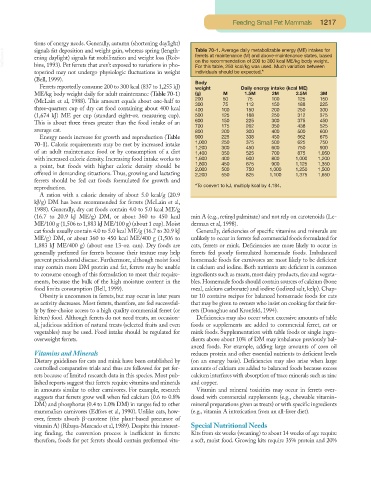Page 1167 - Small Animal Clinical Nutrition 5th Edition
P. 1167
Feeding Small Pet Mammals 1217
tions of energy needs. Generally, autumn (shortening daylight) Table 70-1. Average daily metabolizable energy (ME) intakes for
VetBooks.ir signals fat deposition and weight gain, whereas spring (length- ferrets at maintenance (M) and above-maintenance states, based
ening daylight) signals fat mobilization and weight loss (Rob-
on the recommendation of 200 to 300 kcal ME/kg body weight.
bins, 1993). Pet ferrets that aren’t exposed to variations in pho-
individuals should be expected.*
toperiod may not undergo physiologic fluctuations in weight For this table, 250 kcal/kg was used. Much variation between
(Bell, 1999).
Body
Ferrets reportedly consume 200 to 300 kcal (837 to 1,255 kJ) weight Daily energy intake (kcal ME)
ME/kg body weight daily for adult maintenance (Table 70-1) (g) M 1.5M 2M 2.5M 3M
(McLain et al, 1988). This amount equals about one-half to 200 50 75 100 125 150
300 75 112 150 188 225
three-quarters cup of dry cat food containing about 400 kcal 400 100 150 200 250 300
(1,674 kJ) ME per cup (standard eight-oz. measuring cup). 500 125 188 250 312 375
This is about three times greater than the food intake of an 600 150 225 300 375 450
700 175 262 350 438 525
average cat. 800 200 300 400 500 600
Energy needs increase for growth and reproduction (Table 900 225 338 450 562 675
70-1). Caloric requirements may be met by increased intake 1,000 250 375 500 625 750
1,200 300 450 600 750 900
of an adult maintenance food or by consumption of a diet 1,400 350 525 700 875 1,050
with increased caloric density. Increasing food intake works to 1,600 400 600 800 1,000 1,200
a point, but foods with higher caloric density should be 1,800 450 675 900 1,125 1,350
2,000 500 750 1,000 1,250 1,500
offered in demanding situations. Thus, growing and lactating 2,200 550 825 1,100 1,375 1,650
ferrets should be fed cat foods formulated for growth and
reproduction. *To convert to kJ, multiply kcal by 4.184.
A ration with a caloric density of about 5.0 kcal/g (20.9
kJ/g) DM has been recommended for ferrets (McLain et al,
1988). Generally, dry cat foods contain 4.0 to 5.0 kcal ME/g
(16.7 to 20.9 kJ ME/g) DM, or about 360 to 450 kcal min A (e.g., retinyl palmitate) and not rely on carotenoids (Le-
ME/100 g (1,506 to 1,883 kJ ME/100 g) (about 1 cup). Moist derman et al, 1998).
cat foods usually contain 4.0 to 5.0 kcal ME/g (16.7 to 20.9 kJ Generally, deficiencies of specific vitamins and minerals are
ME/g) DM, or about 360 to 450 kcal ME/400 g (1,506 to unlikely to occur in ferrets fed commercial foods formulated for
1,883 kJ ME/400 g) (about one 13-oz. can). Dry foods are cats, ferrets or mink. Deficiencies are more likely to occur in
generally preferred for ferrets because their texture may help ferrets fed poorly formulated homemade foods. Imbalanced
prevent periodontal disease. Furthermore, although moist food homemade foods for carnivores are most likely to be deficient
may contain more DM protein and fat, ferrets may be unable in calcium and iodine. Both nutrients are deficient in common
to consume enough of this formulation to meet their require- ingredients such as meats, most dairy products, rice and vegeta-
ments, because the bulk of the high moisture content in the bles. Homemade foods should contain sources of calcium (bone
food limits consumption (Bell, 1999). meal, calcium carbonate) and iodine (iodized salt, kelp). Chap-
Obesity is uncommon in ferrets, but may occur in later years ter 10 contains recipes for balanced homemade foods for cats
as activity decreases. Most ferrets, therefore, are fed successful- that may be given to owners who insist on cooking for their fer-
ly by free-choice access to a high quality commercial ferret (or rets (Donoghue and Kronfeld, 1994).
kitten) food. Although ferrets do not need treats, an occasion- Deficiencies may also occur when excessive amounts of table
al, judicious addition of natural treats (selected fruits and even foods or supplements are added to commercial ferret, cat or
vegetables) may be used. Food intake should be regulated for mink foods. Supplementation with table foods or single ingre-
overweight ferrets. dients above about 10% of DM may imbalance previously bal-
anced foods. For example, adding large amounts of corn oil
Vitamins and Minerals reduces protein and other essential nutrients to deficient levels
Dietary guidelines for cats and mink have been established by (on an energy basis). Deficiencies may also arise when large
controlled comparative trials and thus are followed for pet fer- amounts of calcium are added to balanced foods because excess
rets because of limited research data in this species. Most pub- calcium interferes with absorption of trace minerals such as zinc
lished reports suggest that ferrets require vitamins and minerals and copper.
in amounts similar to other carnivores. For example, research Vitamin and mineral toxicities may occur in ferrets over-
suggests that ferrets grow well when fed calcium (0.6 to 0.8% dosed with commercial supplements (e.g., chewable vitamin-
DM) and phosphorus (0.4 to 1.0% DM) in ranges fed to other mineral preparations given as treats) or with specific ingredients
mammalian carnivores (Edfors et al, 1990). Unlike cats, how- (e.g., vitamin A intoxication from an all-liver diet).
ever, ferrets absorb β-carotene (the plant-based precursor of
vitamin A) (Ribaya-Mercado et al, 1989). Despite this interest- Special Nutritional Needs
ing finding, the conversion process is inefficient in ferrets: Kits from six weeks (weaning) to about 14 weeks of age require
therefore, foods for pet ferrets should contain preformed vita- a soft, moist food. Growing kits require 35% protein and 20%

